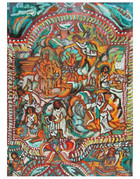Rudolph Valentino Bostic
(1941-2021)
Long before the current "green art" trend began, Rudolph Valentino Bostic was making images on recycled cardboard. This work-horse of heavy duty paper has long been one of my favorite art materials, so it amazes me to see what shimmering wonders this Outsider Artist from Savannah, Georgia, was able to create just by applying enamel house paint from sample color pots onto huge sheets of the discarded material. Noah and the Ark. The visit of the Magi. The Passion of Christ. The Resurrection. From Genesis to the Book of Revelation, the great biblical narratives have all appeared in multiple variations in Bostic's whimsical cardboard panel paintings.
Bostic belonged to the category of "self-taught" artists. He owned few toys when he was growing up, so he learned to draw, making stand-up figures of Cowboys and Indians. Further encouragement came from his uncle, the longtime pastor of the Second African Baptist Church on Green Square in Savannah, who asked Bostic and his brother to make religious pictures for his congregation. What really launched Bostic on a creative career was finding the perfect medium for his art-making in the baking company, where he worked. When Bostic looked at scrap cardboard and ran his fingers along its smooth, solid surface, he thought it would make an ideal "canvas" for working with all the odds and ends of house paint he had at home.
This creator in cardboard was a true visionary artist. He seldom worked from preparatory sketches and almost never retouched finished pictures, which he usually made in one sitting with the cardboard panel, lying in front of him on his bed. With his imagination so steeped in biblical imagery, Bostic gathered his paint pots and brushes, picked up a cardboard panel, and, as he once explained, "the images just come to me." He painted with the television on in the background, so the odd pop culture theme also found its way into his visually busy works. No need to add that Bostic was also a big fan of science fiction.
When I first saw Bostic’s work at a show sponsored by Christians in the Visual Arts, I was intrigued by the series of miniature paintings he used to decorate and frame his central images, something I had only seen before in Eastern Orthodox icons. His cardboard panel pictures are firmly rooted in an Afro-American tradition of “testimony art," meant to share Black historical experiences and religious beliefs. You sometimes get the feeling this artist of faith had so much to say, he continued his narrative right on to the picture frame! Bostic said the inspiration for this striking story-telling device were all the split-screen effects and editing tricks he saw on television.
The Crucifixion I is an excellent example of Bostic's style of double painting. Clustered around Christ on the cross, you can find visual references to Jesus as “Lamb of God” and “Lion of Judah,” the Eucharistic symbols of bread and wine, an open Bible—even the Ark of the Covenant. Some of Bostic's images are less readily identifiable, coming from his own personal store of iconographic prototypes. The empty stool, which figures in the upper left corner of the frame in Christ Carrying the Cross, is visual short hand for Christ's suffering. A stool of this kind can be seen in Bostic's version of the Mocking of Jesus, The Final Hour.
Bostic was a great admirer of Rembrandt, Leonardo, Michelangelo and Raphael and kept a library of art books and clippings of favorite images. From his home study of the Old Masters, Bostic developed a highly individual chiaroscuro style of strongly contrasting light and dark passages, which gives his figures a special vibrancy. This modern master of biblical narrative was less certain what to make of contemporary abstract art forms. "I've looked at the work of other artists, but they're all into symbols and things that aren't real," explained Bostic. "For me, the Bible is the real thing and it's got story after story to paint."
Plagued by poor health in his final years, Bostic made art when he could, creating images of astonishing visual complexity with brilliantily colored pointillist touches. One of the last works to come into the Collection, The Story, brings together some of Bostic's favorite scriptural motifs in a highly decorated jewel box frame, including the temptation of Adam and Eve, David the shepherd boy, Daniel in the lion's den, a healing miracle of Jesus, and what might be the Prophet Elijah taken into heaven or the Ancient of Days of biblical prophecy. There are, of course, angels in plenty. One could ask nothing more from this consummate teller of tales--not in words but in paint.
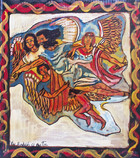
The Creation (After Michelangelo)

Adam & Eve in Paradise

Noah and the Ark
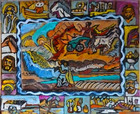
Elijah Taken Into Heaven
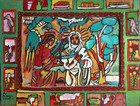
The Annunciation
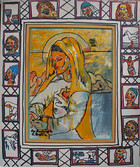
Mother of Peace
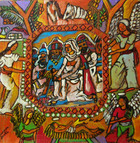
The Nativity
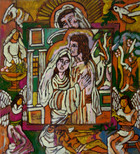
Jesus and Mary
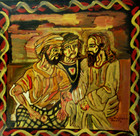
The Call to the Disciples

Jesus Walks on Water

The Prayer in Gethsemane
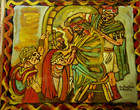
The Final Hour
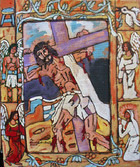
The Way of the Cross
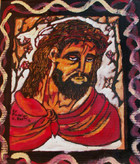
Man of Sorrows
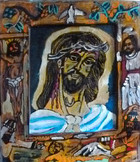
Man of Sorrows II
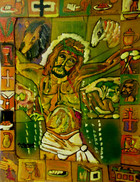
Crucifixion I
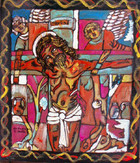
Crucifixion II
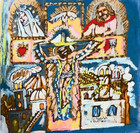
Crucifixion III
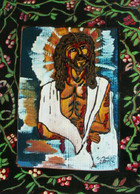
The Resurrection

Blessings Multiplied

Christ & the Angels in Glory
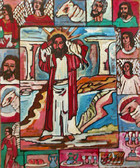
The Good Shepherd
